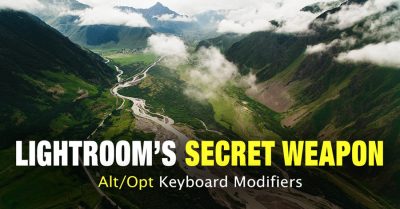In case you are on the lookout for prime Lightroom workflow tricks to optimize and velocity up your modifying course of, you might want to learn this text.
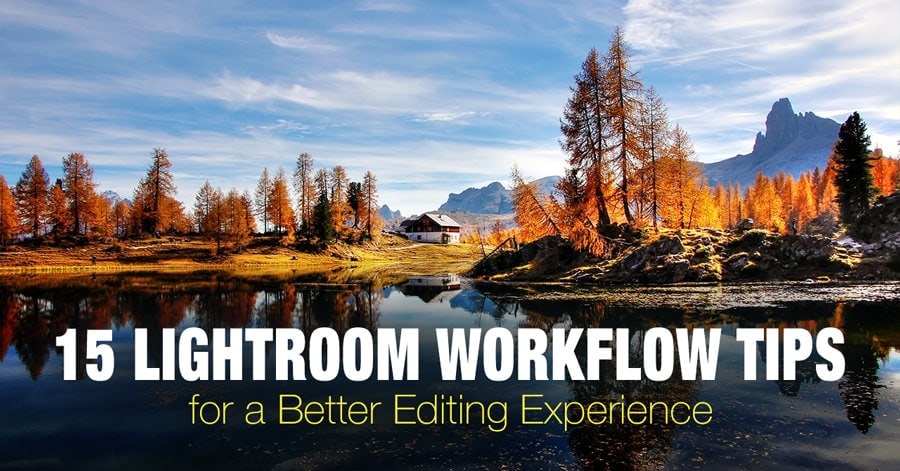
What’s Lightroom Workflow?
Lightroom workflow is a sequence of steps you might want to full, from the second you seize the RAW picture along with your digicam to publishing the ultimate photograph. The Lightroom workflow steps embody importing pictures, culling, keywording, processing, modifying, and at last, exporting and publishing.
Lightroom Workflow Ideas
Lightroom has been round for nearly 20 years and is now a mature and complicated program. You may simply write an 800-page e book devoted completely to Lightroom workflow ideas and methods.
I chosen 15 of my favourite Lightroom workflow ideas for as we speak’s article. The following tips are probably the most impactful to my images and my enterprise, and they’re ones that I exploit every day.
1. Dashing up Lightroom Traditional Efficiency
Lightroom is the only, most essential software for a lot of photographers, together with myself. It’s the middle of not solely our modifying workflows however our images companies as nicely.
We use Lightroom for organizing, modifying, publishing, and printing pictures. Plus, it may be linked to numerous companies with the assistance of plugins.
Our largest annoyance with Lightroom Traditional is its sluggish efficiency and lagging responsiveness.
I’m all the time vital of Adobe, an organization with the best assets within the trade, for failing to handle the efficiency subject after years of empty guarantees.
Since we can not depend on Adobe, we’re pressured to search for options by testing completely different configurations and sharing our findings.
A few years in the past, I printed a devoted article on the subject. Although many of the ideas from the article are nonetheless related, all of the enhancements are marginal. They could provide help to enhance Lightroom’s efficiency by 1% to 2% at most, however that is solely a drop within the bucket.
In the present day, I’ll share my prime tip for bettering Lightroom efficiency by an element of not less than two.
For me, probably the most dramatic change in Lightroom Traditional consumer expertise occurred after I modified my desktop pc’s fundamental onerous drive from an outdated, mechanical spinning drive to a brand new era Stable State Drive (SSD). The SSD makes use of know-how just like what one can find in any flash thumb drive and, consequently, is way quicker and extra dependable.
See additionally: Find out how to Change Lightroom Catalog Location
The primary problem with an SSD is that the know-how remains to be comparatively new and SSDs are dearer than the outdated spinning inside or exterior onerous drives. Which means that I can not afford to purchase the 8TB SSD model to retailer my whole photograph library.
When Lightroom is put in on a quick SSD drive however nonetheless has entry to the RAW recordsdata on a spinning onerous drive, the effectiveness of the SSD setup diminishes.
Right here is my resolution.
Once I return from a visit with hundreds of latest pictures, I create a brief listing on my 1TB SSD drive and import all the brand new pictures there. Which means that I can absolutely benefit from the SSD expertise and its blistering velocity. I hold the brand new pictures within the temp listing till I’m finished processing and modifying them. This would possibly take weeks and even months. As soon as I’m completed, I transfer them into the primary library on the 8TB spinning drive.
I like to recommend the EVO Samsung SSD fashions as a result of they’ve the perfect migration software program. This permits seamless migration from the outdated drive with out reinstalling the working system. Additionally, it doesn’t require technical data. I’ve finished this efficiently twice.
2. Use AUTO Tone Mode
AUTO Tone might be probably the most obscure and least used characteristic in Lightroom. Yow will discover it within the Develop Mode below the Primary Panel. By urgent the AUTO button, you let Lightroom determine what actual edits to use to the chosen picture.
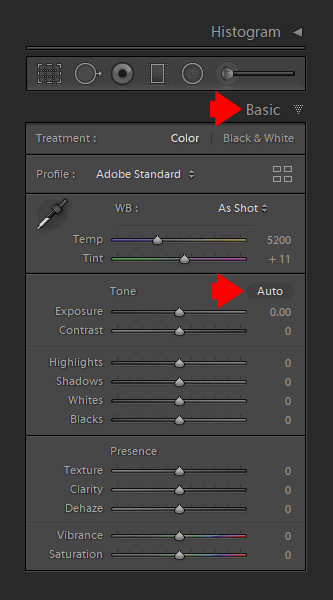

AUTO Tone was accessible in Lightroom for a very long time and was just about a ineffective characteristic that produced unpredictable outcomes. However, with the advances in Synthetic Intelligence and Machine Studying, AUTO Tone is getting higher and higher at evaluating pictures and making use of the suitable edits.
Don’t disregard AUTO Tone. Strive it with each picture as a result of, generally, it will provide you with an awesome start line in your modifying course of.
If you wish to take this even additional, create a Develop Preset with solely the AUTO Tone edit recorded. Apply it to all of your pictures throughout the import course of to offer each new photograph a novel modifying baseline.
Assets:
3. Use Selective Saturation
After we shoot JPEG, the digicam takes the info collected from the sensor and runs it by means of the digicam processor. The processor converts the uncooked information to the picture, applies completely different edits, together with saturation and distinction, based mostly on predefined algorithms, and saves the picture as a JPEG file. After we shoot RAW, it’s as much as the photographer to determine what edits to use to any particular picture.
One of the vital essential choices we’ve to make is the best way to correctly tackle picture saturation.
You in all probability seen that saturation might make or break your picture. When utilized correctly, it could actually deliver any picture to life. However, on the similar time, additionally it is very straightforward to destroy a photograph with oversaturation.
Each Lightroom consumer is aware of the 2 fundamental instruments to manage saturation in pictures—Saturation and Vibrance, that are positioned below the Primary Panel.
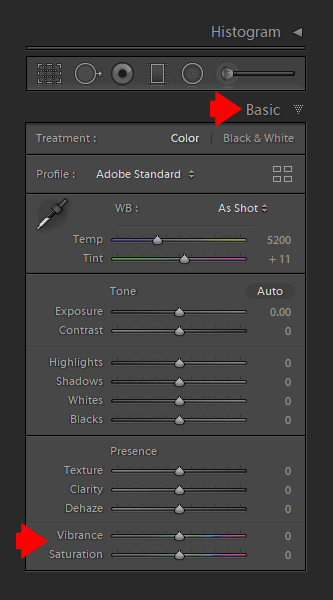

The Saturation slider equally will increase the colour depth to all the colours. The Vibrance software applies saturation disproportionally, prioritizing colours with decrease depth.
Once you use the Saturation, the Vibrance, or a mixture of each, you find yourself with a photograph the place all the colours have boosted saturation. It’s tough to emphasise one particular shade or group of colours for a greater visible affect.
To have higher management over shade saturation, I exploit a special method. I exploit the HSL (Hue, Saturation, Luminance) panel. This panel permits me to selectively management the saturation for each picture shade.
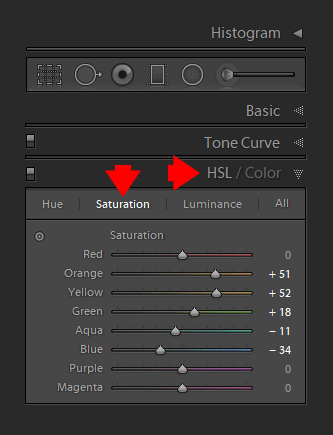

For instance, if I need to emphasize the vegetation in my panorama photograph, I enhance the saturation of solely the yellows and greens. I’d even cut back the saturation of the sky (blue shade) to make it simpler to attract the viewer’s consideration.
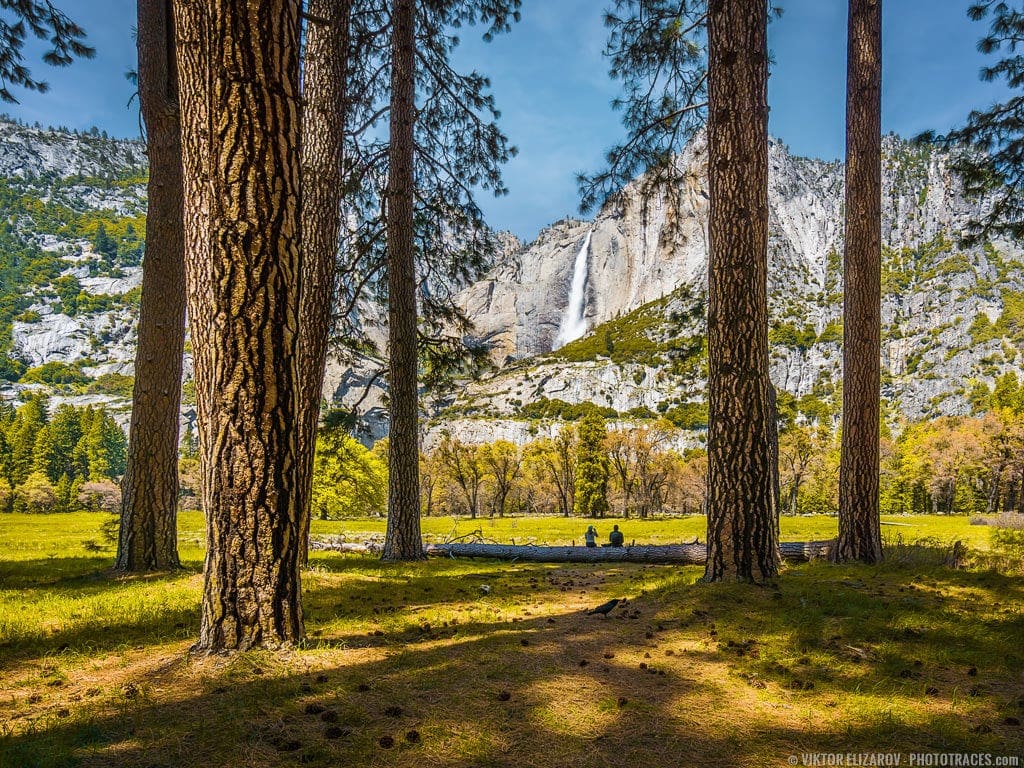

4. Maximize the Tonal Vary in Your Photographs
Maximizing the tonal vary means utilizing the whole vary of tones from pure black to pure white.
For instance, once you take a photograph on an overcast and gloomy day, the photograph may have a restricted tonal vary of principally greys with out very darkish or shiny tones.
We will maximize the tonal vary of any given photograph by setting the black and white factors.
Lightroom has built-in performance for setting black and white factors. This can be a semi-automated course of.
Open the Primary Panel of the Develop Module.
Maintain down the SHIFT key and double-click the Whites label on the left facet of the modifying slider. Lightroom will robotically set the White Level by setting the Whites worth to a most worth that doesn’t introduce pure white.
Subsequent, maintain down the SHIFT key and double-click the Black label. Lightroom will robotically set the Black Level by setting the Black worth to a minimal with out clipping it (introducing pure black).
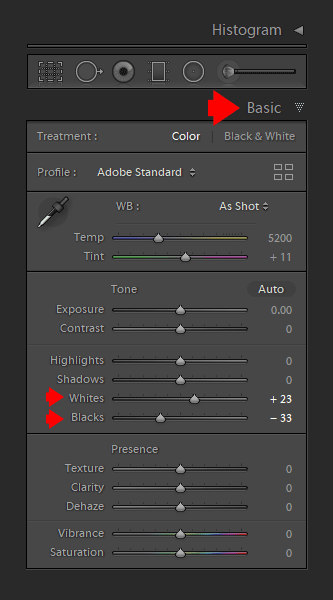

The result’s a picture with a full tonal vary.
If you wish to discover ways to use this straightforward method when modifying panorama pictures, try the next tutorial: Find out how to Set Black and White Factors in Lightroom
5. Use the Good Distinction Approach
Distinction is one other essential method that we apply to just about each picture we edit. Correctly utilized Distinction makes the picture pop and creates a better visible affect.
In Lightroom, there’s a devoted Distinction Slider within the Primary Panel. The way in which the Distinction performance works is that it makes darker colours darker and brighter colours brighter by creating a better tonal distinction between the darkish and shiny areas of the picture.
However since we can not individually management at what diploma this system impacts the darkish and shiny tones, it’s usually not possible to maximise the distinction with out clipping the whites or blacks.
I exploit a special method to have higher management over the Distinction. I exploit the Area sliders within the Tone Curve Panel.
Right here is my typical slide configuration for panorama pictures.
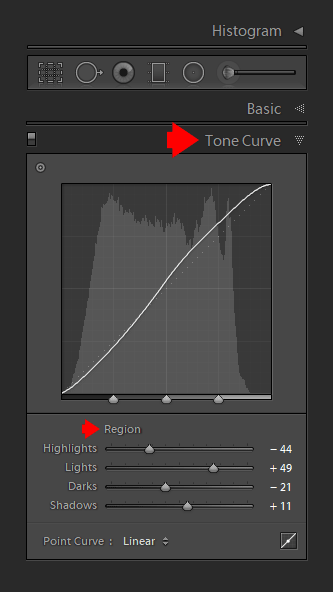

First, I need to guarantee I shield the brighter areas of the picture from unintentional clipping. I set the Spotlight worth to -44.
I additionally need to shield the darkish tones. I set the Shadows worth to +11.
Subsequent, I begin experimenting by rising the Lights’ worth and reducing the Darks’ worth.
After all, each picture is completely different and requires a special Area slider configuration. Usually, I enhance the Lights to a a lot greater diploma than how a lot I cut back the Darks.
The flexibility to regulate the brilliant and darkish areas of the photograph individually offers us significantly better management over the distinction adjustment course of.
6. Use Batch Modifying
Batch Modifying is the method of modifying a number of pictures concurrently. It may well probably save an infinite period of time when used correctly.
The most typical Batch Modifying method is when you choose a number of pictures in Lightroom and apply the Develop Presets to all of them. Although this can be a very fashionable method to Batch Modifying, I hardly use it. I discover that even after making use of a preset to 20-30 pictures, I nonetheless spend hours tweaking every photograph individually.
I exploit a special technique as an alternative.
I most frequently use Batch Modifying with pictures taken on the similar location. For instance, when I’ve 50 new pictures after capturing a sundown, I do know that each one the pictures have been taken in related lighting circumstances utilizing a comparable capturing method. This implies the pictures would require an identical modifying method.
I choose a single photograph that greatest represents the capturing scene. I exploit the Fast Modifying workflow by making use of the model Develop Preset first, after which I exploit the Toolkit Preset Assortment to finetune the picture. If needed, I’d manually tweak a few the modifying sliders, probably from the HSL Panel, to regulate the person colours individually.
When I’m proud of the ultimate end result, I choose the remainder of the pictures from the shoot and apply the identical edits to all of them. I exploit one of many strategies I outlined on this article: Find out how to Batch Edit in Lightroom.
Utilizing this Batch Modifying technique produces the perfect outcomes. I hardly have to do any modifying to the person pictures.
7. Use Selective Sharpening in Lightroom Traditional
Usually, I don’t use default Noise Discount and Sharpening in Lightroom. I desire Photoshop as an alternative as a result of I discover that it offers me extra choices with extra superior strategies to maintain noise below management.
Let me clarify.
Once I sharpen my panorama pictures, I all the time apply sharpening selectively. I by no means need to sharpen the world of the sky or the water; I’ll even soften these areas utilizing noise discount.
Associated: My Favourite Approach to Add Vignetting in Photoshop
In Photoshop, I apply sharpening to the whole picture first after which use the transparency masks to have an effect on solely the chosen areas.
Although Selective Modifying in Lightroom is proscribed, we nonetheless have some management over-sharpening. After making use of sharpening to the whole picture, you possibly can open the Particulars Panel and use the Masking slider to slim the affected space.
Right here is the primary trick—maintain the Alt/Decide key down when dragging the Masking slider to raised visualize the affected space. The realm affected by the sharpening will present in white, and the unaffected space will present in black. By utilizing excessive Masking values (90-100), you possibly can restrict the sharpening impact to solely the perimeters of the photograph.
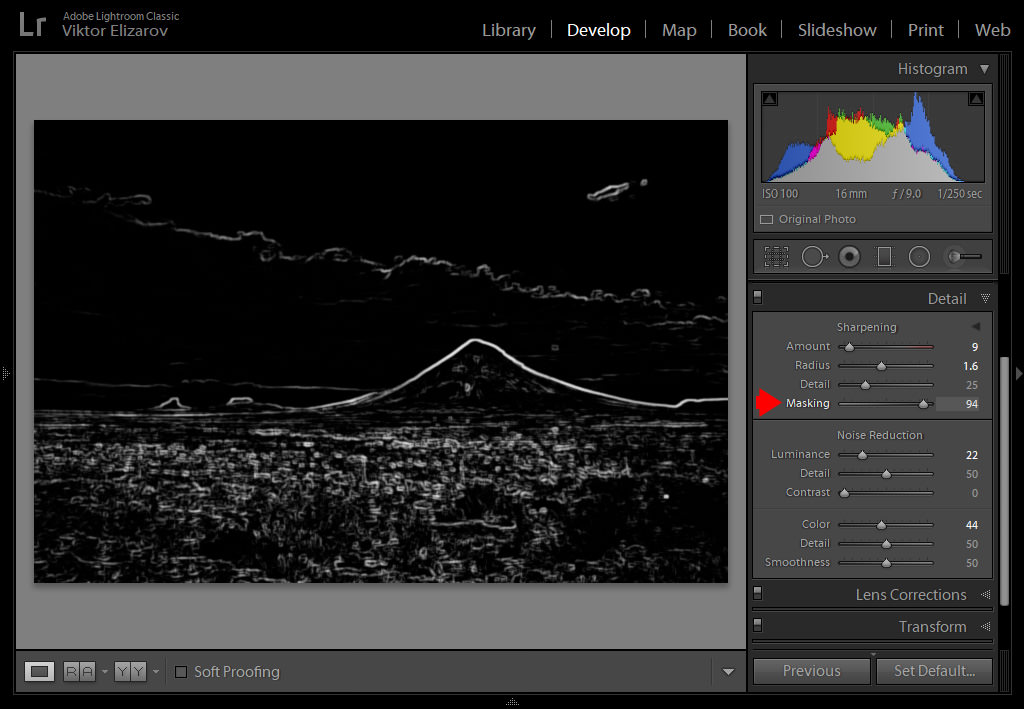

I exploit this Selective Sharpening method after I wouldn’t have time for Photoshop modifying.
8. Use Import Presets
The preset performance is a basis of Lightroom. This system makes use of 9 various kinds of presets (develop presets, metadata presets, filter presets, export presets, and so forth.) in numerous areas to assist photographers velocity up and automate the whole modifying course of.
I think about the Import Presets to be one of the crucial helpful and, on the similar time, probably the most underutilized software by many photographers.
Surely, Lightroom’s Import Module is probably the most complicated and least intuitive space of this system. It causes probably the most headache and confusion for brand spanking new Lightroom customers.
The easiest way to beat the complexity of the Import Module is to create Import Presets and use them with each import.
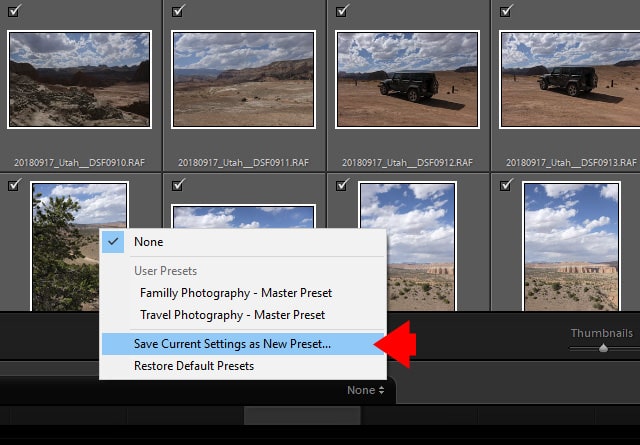

Assets:
9. Use the Histogram as an Modifying Device
In images, the Histogram is the graphical illustration of pixels distributed in any given photograph based mostly on its brightness.
The Histogram is a photographer’s greatest good friend. When utilized in a digicam, histograms assist us produce well-exposed pictures. When utilized in Lightroom or another photograph modifying program, histograms assist us fine-tune or appropriate the publicity.
In Lightroom, the Histogram is greater than an informational perform. Additionally it is an modifying software.
Within the Develop Module, for those who transfer the mouse over the Histogram, you possibly can choose 5 completely different areas. By dragging the mouse to the appropriate and left, you possibly can visually alter the next parameters—Blacks, Shadows, Publicity, Highlights, and Whites.
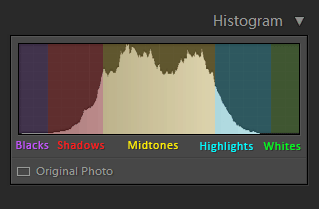

It’s principally gamification of the modifying course of. It’s enjoyable to see how reshaping the Histogram impacts the corresponding photograph.
Assets:
10. Study Solely the Important Shortcuts
I wouldn’t have to persuade anybody that keyboard shortcuts can drastically velocity up the usage of any pc program. All of us perceive that. However studying keyboard shortcuts in Lightroom is more difficult than in another program, together with Photoshop. First, there are over 100 shortcuts in Lightroom. Second, the identical shortcut can have completely different features in numerous program modules.
My method to Lightroom shortcuts is to study solely the most important and helpful shortcuts to your Lightroom workflow and disrespect the remainder.
For instance, my all-time favourite shortcut is “” (backslash), which reverts the chosen picture to the unique state with out altering the crop changes. It’s one of the best ways to test the outcomes of your modifying. The shortcut is known as Earlier than & After.
There may be one other helpful trick for memorizing probably the most helpful keyboard shortcuts in Lightroom. You should utilize the Panel Finish Mark perform to show the cheat sheet with all of your favourite shortcuts contained in the facet panels.
Try the tutorial under to discover ways to obtain probably the most helpful shortcuts cheat sheet and show it in Lightroom.
Assets:
11. Use the Energy of Alt/Decide Key
Keyboard shortcuts in Lightroom set off sure features in this system. They merely save time. However there’s one other set of keyboard keys that perform fairly a bit in a different way. They modify or prolong the features of the prevailing modifying instruments. I name these “keyboard modifiers.”
An important keyboard modifier in Lightroom is the Alt/Decide key. The frequent position of the Alt/Decide modifier is as a reset perform. For instance, by holding down the Alt/Decide key within the Primary Panel, new reset choices (Reset Tone and Reset Presence) seem. You possibly can reset a number of modifying sliders again to their default values by clicking the brand new reset choice. The Alt/Decide key triggers reset choices in nearly each modifying panel.
One other helpful perform of the Alt/Decide keyboard in Lightroom is visualization. It helps you see the affected space of the modifying perform, comparable to sharpening, noise discount, or cut up firming.
For a full record of the Alt/Decide features, try this text right here: Lightroom’s Secret Weapon – Alt/Decide Keyboard Modifiers
12. Change Masks Colour of Adjustment Instruments
When Lightroom was initially launched, it had no selective modifying instruments. Results might solely be utilized to the whole picture. For selective modifying, you had to make use of Photoshop.
Over time, Adobe added a spread of selective adjustment instruments to dramatically change the usefulness and flexibility of this system.
The Adjustment Brush, the Graduated Filter, and the Radial Filters are instruments that made Lightroom an modifying powerhouse appropriate for any kind of images.
To higher visualize the impact of the adjustment software, you merely use the shortcut “O” (it stands for “overlay”) and Lightroom exhibits the affected space of the picture in crimson (the default shade).


In case your picture has predominantly crimson colours, it’s tough to visualise crimson in opposition to the default crimson. Use the shortcut “Shift+O” to vary the colour of the overlay. Your choices are inexperienced, crimson, blue, and gray.
13. Use Solo Mode in Develop Module
Lightroom has 9 complete modifying panels within the Develop Module. When you might have all of the panels open, discovering the modifying slider you want may be extraordinarily tough. Plus, the whole modifying course of turns into an train in consistently scrolling by means of the prolonged panels.
Fortunately, there’s an alternative choice. Solo Mode lets you have just one modifying panel open at a time.
To entry Solo Mode, right-click the header of any modifying panel and choose the Solo Mode choice.
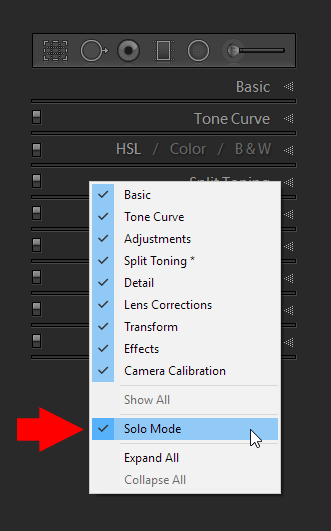

In my case, Solo Mode is all the time energetic and retains my UI neat.
14. Use Information Overlays When Cropping Photographs
If I needed to estimate, I might say that I exploit the Crop Overlay software with 99% of the pictures I edit. After all, I all the time attempt to get the appropriate composition within the digicam, however even after I succeed, every photograph requires some tweaking.
Generally, I have to straighten the horizon or crop out a distractive rock. Different instances I need to enhance the composition by making it tighter.
That is when the Information Overlay comes into play. The software is a visible helper that makes our job of bettering composition a lot simpler.
When the Crop Overlay software is energetic, use the “O” shortcut (“overlay”) to cycle by means of the seven choices—Grid, Thirds, Diagonals, Triangle, Golden Ratio, Golden Spiral, Facet Ratios.


In my case, I most frequently use the Golden Ratio and Thirds.
15. Use Cap Lock Autoadvance Mode
Once I have to undergo hundreds of pictures to charge them as “rejects” and “keepers,” the Autoadvance Mode in Lightroom’s Library Module is available in very useful.
Hit the Caps Lock button to activate it.
With the Autoadvance Mode activated, hitting the “P” (“decide”) shortcut flags the picture and robotically advances to the following picture. This looks like solely a small assist, however it saves an awesome period of time when culling a lot of pictures.
Assets:
FAQ: Lightroom Workflow
How can I streamline the export course of in Lightroom for various functions?
To streamline the export course of in Lightroom for numerous functions, I depend on the creation of export presets. This resolution will not be groundbreaking, however it proves extremely efficient. By growing a set of export presets, I can effortlessly apply them to completely different situations.
I’ve crafted particular export presets tailor-made for web use, using the JPEG file format and making certain a small file dimension. These presets permit me to keep up management over vital elements comparable to file format, picture dimension, file renaming, and even sharpening.
Furthermore, I’ve established devoted export presets for situations the place high-resolution recordsdata are needed, significantly for print functions. This flexibility in presets caters to completely different output necessities with out the necessity for handbook changes every time.
For these searching for extra detailed steerage on my method, I’ve put collectively a devoted tutorial on “Lightroom Export Settings,” offering complete insights into optimizing the Lightroom export workflow for numerous wants.
What’s the significance of utilizing key phrases in Lightroom?
Utilizing key phrases in Lightroom is crucial for effectively organizing your photograph library. Keywording is a strong software. Hanging a steadiness between inadequate and too many is essential for a easy Lightroom workflow. If you happen to neglect keywording, discovering particular pictures turns into difficult. Alternatively, extreme keywording can complicate your workflow, making it time-consuming.
As a journey and panorama photographer, I primarily key phrase my RAW recordsdata based mostly on the areas the place my pictures have been taken. Moreover, for household images, I exploit key phrases for particular person members of the family. This method streamlines my workflow and meets my wants with out pointless complexity.
I make use of superior strategies comparable to good collections to reinforce my group additional. As an illustration, after I add a key phrase like “Yosemite Nationwide Park” to a picture, it robotically populates in my Yosemite good assortment. This automation saves time and provides a layer of effectivity to my workflow.
Discovering the appropriate steadiness in your keywording technique is crucial. It ensures that your pictures are adequately tagged.
What’s one of the best ways to cull and choose the perfect pictures in Lightroom?
As a panorama photographer, I usually return from a shoot with a thousand new pictures, and culling them turns into a vital element of my processing workflow. The target is to effectively cull the gathering right down to the best pictures with out ready time.
The culling begins promptly after I’ve inserted my reminiscence card into the card reader, and the batch is imported into Lightroom. I navigate to the Library module to start out my two-pass culling course of.
Within the first cross, I focus solely on figuring out and rejecting pictures that don’t make the reduce. This consists of any out-of-focus photographs, unintentional photographs, situations of overexposure with blown highlights, and people with crooked horizons which are past correction.
On the second cross, I am going by means of the remaining pictures, flagging these with potential for future processing and publishing. I don’t use shade labels or star rankings; flagging is all I do. Generally, if needed, I’ll make preliminary changes to the white steadiness or horizon strains to raised consider a photograph’s prospects.
This streamlined method to culling in Lightroom is a pivotal a part of my workflow course of, permitting me to simply kind by means of hundreds of pictures.
What’s the key to efficient lightroom workflow?
The important thing to an efficient non-destructive workflow in Lightroom revolves round consistency and customization tailor-made to your private model and effectivity. Whereas there isn’t a singular “good” workflow in Lightroom, discovering an optimum course of that marries your images model and modifying habits is essential.
An efficient workflow begins when you import picture recordsdata out of your reminiscence card into Lightroom. Being methodical and constant on this course of, from culling to paint firming, by means of numerous modifying steps, and culminating within the export, is significant. When these steps turn out to be second nature, it reduces redundancy and accelerates your modifying course of.
Moreover, make use of Lightroom’s presets to assist your workflow. By successfully using import presets, making certain constant file naming and renaming, making use of watermark presets, develop presets, and setting export presets, you streamline your workflow and guarantee a uniform end result all through your initiatives. Catering your workflow to your wants not solely refines your post-processing however will invariably prevent time for the inventive side of images.
Lightroom Workflow Ideas: Conclusion
I listed 15 of my favourite Lightroom workflow ideas which have the strongest affect on my images. You wouldn’t have to memorize or study all of them. Merely choose those that may considerably enhance your photograph modifying workflow and incorporate them into your modifying course of.





